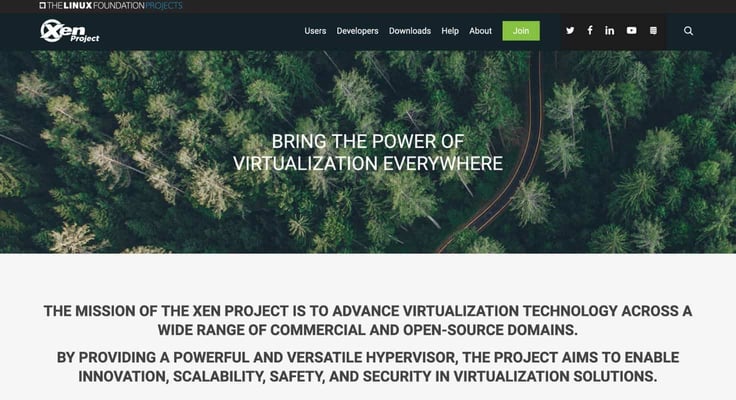
TL; DR: Virtualization technology is the foundation of various products and services within the tech sphere. It offers users the flexibility to build and develop solutions more efficiently by allowing them to break free from constrained hardware setups. The Xen Project is on a mission to bring virtualization everywhere by providing developers with an open-source hypervisor that supports hyperscale cloud platforms and multiple operating systems. We spoke with Kelly Choi, Open-Source Community Manager of The Xen Project, about the platform, its security-first environment, and its open-source framework.
Developers looking for freedom and flexibility can benefit from using virtualization technology. It allows them to get more utilization out of their physical hardware by creating a virtual version of the physical environment. Although many developers use virtualization today for software development, not too long ago, it was primarily used to consolidate servers and make better use of underutilized resources.
Now, developers can leverage virtual machines to test software in multiple environments using one physical piece of hardware. They do this with a crucial component of technology called hypervisors — the process that creates and runs virtual machines. The Xen Project is an open-source project bringing the power of virtualization to all developers, no matter who they are.
“What’s great about our hypervisor is that so many people around the industry use it. And the main feature of it is that it supports multiple guest operating systems and platforms. The architecture itself is flexible,” said Kelly Choi, Open-Source Community Manager of The Xen Project.

Thanks to its open-source framework, the Xen Project delivers highly customizable and versatile hypervisor software that suits various workloads. The Xen Project also prides itself on security, leveraging industry best practices and ensuring security-first environments for users.
Hosted by the Linux Foundation, the Xen Project is the number one choice for public cloud users and has a massive open-source community behind it, keeping it updated and functional for years to come.
“There are so many future capabilities around virtualization, and The Xen Project isn’t going away. Our community is working on lots of great things such as how to continuously improve security, and safety within critical systems. You can only imagine the potential things that can be achieved in spaces such as embedded and automotive,” said Kelly.
The Xen Project Unlocks the Power of Virtualization
The Xen Project got its start at Cambridge University in 2003. Ten years later, the project joined the Linux Foundation. From these humble beginnings, it established a firm reputation in the open-source and development community, becoming one of the top hypervisors in the industry. Its maturity, versatility, and stability have made it an excellent foundation for many virtualization-related open-source projects.
“The architecture is flexible. So it gives vendors the ability to create Xen-based products for servers, cloud, desktop, embedded, and secure diverse environments,” said Kelly.
What makes the Xen Project so unique is its versatility. Its architecture allows users to create projects across a wide range of commercial and open-source domains and supports multiple operating systems and cloud platforms.

A lot of this advancement starts with the Xen Project Advisory Board. Kelly told us the project board members include AWS, ARM, AMD/XILINX, EPAM, Vates and XenServer. .
“Our board members not only contribute toward the project’s strategic vision but they all work together in terms of how the hypervisor can work on different systems since a few members are developers themselves,” said Kelly.
More than 10 million people use the Xen hypervisor to create, innovate, and scale solutions, showing its reliability. The project also enables high scalability and security to support the most critical workloads and environments.
The Safest Hypervisor for Security-First Environments
The Xen Project’s security is one of the top reasons many users flock to its virtualization technology. Its security is robust and meets the needs of the most critical systems. Kelly said the Xen Project’s secure architecture distinguishes it from other hypervisors.
“It’s very secure. So, in terms of minimal attack surfaces, it has many key security features. It has KCONFIG and virtual machine introspection. That’s what a lot of developers talk about,” said Kelly.
The Xen Project uses a multilayered protection and detection approach to ensure developer workloads are always safe within its walls. Its advanced security features, industry-leading disclosure process, and architecture combine to provide top-level protection and create a minimal attack surface for threats.
“We have a strict security process. One of the current projects that we’re working on is future capabilites within automotive and embedded. So with safety critical systems where you must have specific guidelines, it’s chosen because of its maturity and robust security features,” said Kelly.
Although the hypervisor software is secure, the Xen Project provides an additional layer of security by vetting its projects with its security disclosure process. Code must meet MISRA C requirements to ensure it follows security standards.
“So we have a certain way of doing code where it has to be right. Because if we’re implementing code in safety security systems, it has to perform in a certain way,” said Kelly.
Open-Source: Making Use of Diverse Perspectives
Open-source is the lifeblood of the Xen Project. The project runs and advances with the contributions of open-source members. Kelly said the diversity of opinion is the strength of the Xen Project’s open-source framework. It allows the project to support and discover new opportunities from vendors and users alike.
“Anyone who wants to contribute is more than welcome. However, code and review patches do require a certain level of expertise because of the project’s complexity and long-term history. The advantage is that many different people contribute, helping open source achieve the best of the best,” said Kelly.
Each project within the Xen Project has its own maintainers who perform strict review patches to ensure that contributions are up to par for the platform. The Xen Project must also meet the rules and guidelines of the Linux Foundation, since it is under its governance.
Kelly encourages anyone interested in open-source projects to contact the Xen Project which has an active community and is always looking for more people to join.
“People who want to get involved should come to our website and join our mailing list. That’s where a lot of the activity takes place. We want to reach as many people as possible and let them know what open-source is about and how we can help others,” said Kelly.


